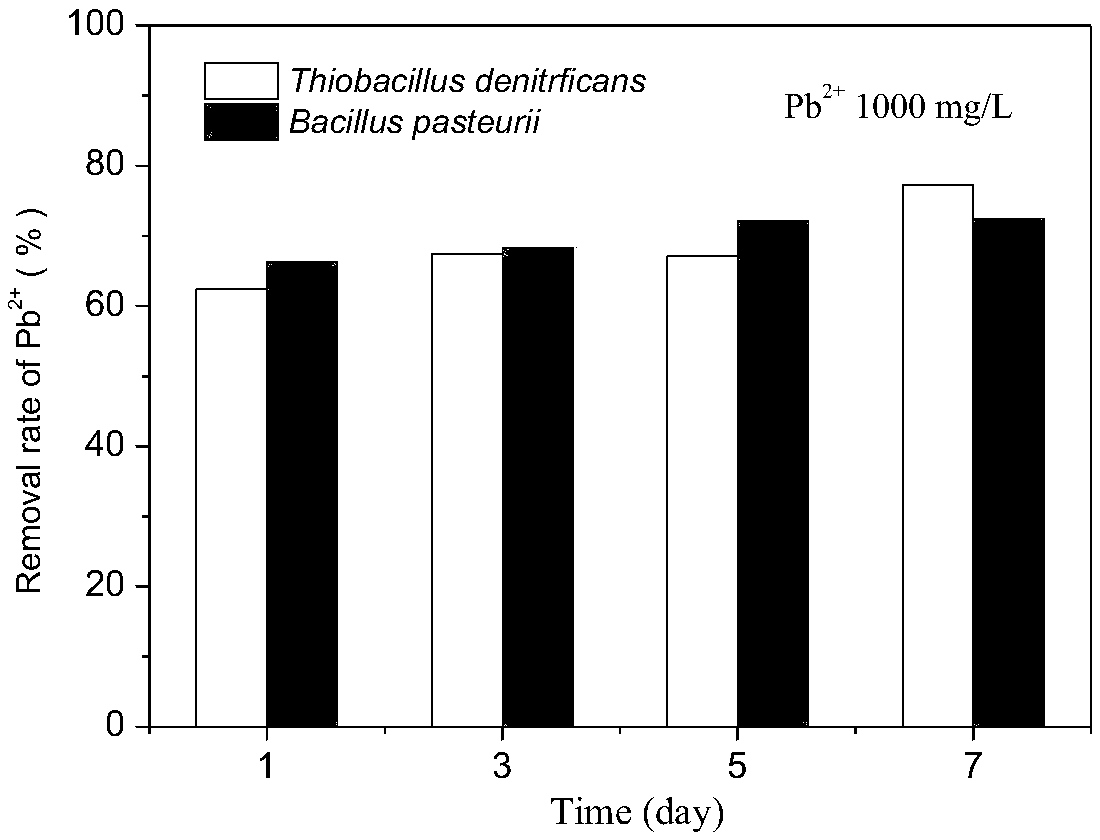A method for joint treatment of lead ion pollution by using carbonate mineralizing bacteria-thiobacillus denitrification
A combined treatment technology of Thiobacillus denitrificans, applied in the field of resources and environment, to achieve the effect of improving removal efficiency, broad application prospects, and outstanding environmental friendliness
- Summary
- Abstract
- Description
- Claims
- Application Information
AI Technical Summary
Problems solved by technology
Method used
Image
Examples
Embodiment 1
[0016] Example 1 A method of utilizing carbonate mineralizing bacteria-Thiobacillus denitrification to jointly treat lead ion pollution, applying compound fertilizers containing urea and ammonium thiosulfate to a lead concentration of 50 mg / kg of soil, after 1 day, the concentration of the prepared bacteria was 0.5×10 8 ~5.0×10 8 cfu / mL of carbonate mineralizing bacteria solution according to 0.5L / m 2 The proportion of the above soil was added to keep the temperature range between 20°C and 30°C. After 1d, press 1.0L / m 2 The ratio of adding the prepared strain concentration is 0.5×10 8 ~5.0×10 8 cfu / mL of Thiobacillus denitrificans, use the system of carbonate mineralizing bacteria-Thiobacillus denitrificans to react with lead ions for 7 days, sample 10mL and centrifuge at 4000r / min for 10min, take 1.0mL of supernatant, dilute it for testing The residual lead ion concentration in the soil, the final removal rate of lead ion is 90%.
Embodiment 2
[0017]Example 2 A method of utilizing carbonate mineralizing bacteria-Thiobacillus denitrification to jointly treat lead ion pollution, applying compound fertilizers containing urea and ammonium thiosulfate to a lead concentration of 100 mg / kg of soil, after 2 days, the concentration of the prepared strains will be 0.5×10 8 ~5.0×10 8 cfu / mL of carbonate mineralizing bacteria solution according to 1.0L / m 2 The proportion of the above soil was added to keep the temperature range between 20°C and 30°C. After 2d, press 1.0L / m 2 The ratio of adding the prepared strain concentration is 0.5×10 8 ~5.0×10 8 cfu / mL of Thiobacillus denitrificans, use the system of carbonate mineralizing bacteria-Thiobacillus denitrificans to react with lead ions for 8 days, sample 10mL and centrifuge at 4000r / min for 10min, take 1.0mL of supernatant, and dilute it for testing The residual lead ion concentration in the soil, the final removal rate of lead ion is 94%.
Embodiment 3
[0018] Embodiment 3 A kind of method that utilizes carbonate mineralization bacterium-thiobacillus denitrification to jointly process lead ion pollution, apply the compound fertilizer containing urea and ammonium thiosulfate to lead concentration to be 200mg / kg of soil, after 2 days, the concentration of the prepared strains will be 0.5×10 8 ~5.0×10 8 cfu / mL of carbonate mineralizing bacteria solution according to 2.0L / m 2 The proportion of the above soil was added to keep the temperature range between 20°C and 30°C. After 2d, press 2.0L / m 2 The ratio of adding the prepared strain concentration is 0.5×10 8 ~5.0×10 8 cfu / mL of Thiobacillus denitrificans, use the system of carbonate mineralizing bacteria-Thiobacillus denitrificans to interact with lead ions for 10 days, sample 10mL and centrifuge at 4000r / min for 10min, take 1.0mL of supernatant, and dilute it for testing The residual lead ion concentration in the soil, the final removal rate of lead ion is 95.9%.
PUM
| Property | Measurement | Unit |
|---|---|---|
| tolerance concentration | aaaaa | aaaaa |
| tolerance concentration | aaaaa | aaaaa |
Abstract
Description
Claims
Application Information
 Login to View More
Login to View More - R&D
- Intellectual Property
- Life Sciences
- Materials
- Tech Scout
- Unparalleled Data Quality
- Higher Quality Content
- 60% Fewer Hallucinations
Browse by: Latest US Patents, China's latest patents, Technical Efficacy Thesaurus, Application Domain, Technology Topic, Popular Technical Reports.
© 2025 PatSnap. All rights reserved.Legal|Privacy policy|Modern Slavery Act Transparency Statement|Sitemap|About US| Contact US: help@patsnap.com


